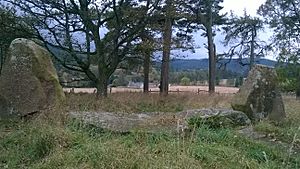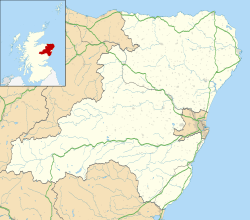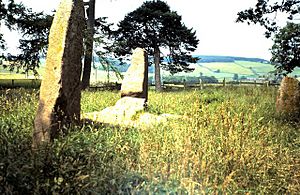Sunhoney facts for kids

Recumbent and flankers in 2020
|
|
| Location | Scotland |
|---|---|
| Region | Aberdeenshire |
| Coordinates | 57.14132°N 2.47068°W |
| OS grid reference | NJ715057 |
| Type | Recumbent stone circle |
| Site notes | |
| Public access | Yes |
| Designated | 1925 |
| Identifiers | |
| Historic Environment Scotland | SM44 |
Sunhoney is an ancient stone circle found in Aberdeenshire, Scotland. It is a special kind of stone circle known as a "recumbent stone circle." These types of circles are often seen in the Grampian region, especially near the River Dee.
Sunhoney is located about 2 kilometers west of the village of Echt. It is also close to other stone circles, such as Cullerlie and Midmar. Sunhoney is protected as a "scheduled ancient monument" because of its historical importance.
Contents
What are Recumbent Stone Circles?
A recumbent stone circle is a unique type of stone circle built long ago. People created them during the early Bronze Age. The main feature of these circles is a very large stone called the "recumbent." This stone always lies flat. It is usually placed so its longest side points between the south and southwest.
Key Features of These Circles
Two tall stones, called "flankers," stand on each side of the recumbent stone. These flankers are usually the tallest stones in the whole circle. The smallest stones are typically found on the northeast side. The rest of the circle usually has six to ten other upright stones. These stones are often arranged by size, getting smaller as they go around.
Builders often chose flat areas on hills for these circles. These spots offered great views of other important places. More than seventy of these circles exist in lowland Aberdeenshire in northeast Scotland. Similar ancient monuments, called "axial stone circles," are found in southwest Ireland.
What Was Inside?
Recumbent stone circles usually had a low mound of stones, called a "ring cairn," inside them. Over many centuries, these mounds have often disappeared. Some experts think these circles might have developed from Clava cairns, which are found nearby.
We don't know the exact purpose of these circles. However, burnt human remains have been found at some sites. This suggests they might have been used for burials or other important ceremonies.
Exploring Sunhoney Stone Circle
The Sunhoney stone circle is about 25.40 meters wide. It is made up of 12 stones in total. This includes the large recumbent stone, its two flanker stones, and nine other stones.
Unique Markings on the Stones
The main recumbent stone has broken into two pieces. It also has many small hollows carved into its surface. These are called "cup marks." People have counted these marks differently, finding either 28, 30, or 31 in total.
Discoveries Inside the Circle
Inside the stone circle, there is a ring cairn. In 1865, a researcher named Charles Dalrymple dug into the site. He found evidence of cremations, which are burnt human remains.
Because Sunhoney is still in good condition, researchers have studied it to understand "archaeoastronomy." This is the study of how ancient people used the sky, like the sun and stars, for their buildings. Norman Lockyer was the first to study Sunhoney in this way. Later, George Browne, Alexander Thom, Aubrey Burl, and Clive Ruggles also worked at the site. They noticed that the recumbent stone faced Blackyduds hill. The most recent study of the stones' geology happened in 2006.
Sunhoney is protected as a scheduled ancient monument. Another recumbent stone circle is about 2 kilometers west, near the church of Midmar. The Cullerlie stone circle is also close by.



